6 ways to use concept mapping in your research

Joseph Novak developed concept mapping in the 1970s and ever since, it has been used to present the construction of knowledge. A concept map is a great way to present all the moving parts of your research project in one visually appealing figure. I recommend using this technique when you start thinking about your new research topic all the way through to the end product, and once you submitted your thesis, dissertation or research article, you can use concept mapping to plan your next project. If you prefer to watch the video explaining the 6 steps, scroll down.

What is the purpose of concept mapping?
You may wonder what the purpose of a concept map is. A concept map shows the different “ideas” which form part of your research project, as well as the relationships between them. A concept map is a visual presentation of concepts as shapes, circles, ovals, triangles or rectangles, and the relationships between these concepts are presented by arrows. Your concept map will show the concept in words inside a shape, and the relationship is then presented in words next to each arrow, so that each branch reads like a sentence. What is the difference between a mind map and a concept map? A mind map is different from a concept map in that a mind map puts much less emphasis on the relationship between concepts.
How to use a concept map in your research
Don’t wait to put your concept map together until only after you have, what you consider, “all the knowledge” and have read “all the literature” (anyway, with two million research articles published each year, will that day ever come?). In the very early stages, when you start thinking about your research project, draw your concept map to get your thoughts organised. Then, as you become more and more abreast with the research out there, modify your concept map.
The process of creating a concept map is an iterative one and you will find that it feels like you have drawn and redrawn the map over and over so many times that you wonder if you are ever going to get to a final version. This process in itself is a learning experience and is vital to sort the concepts out for yourself. If you have clarity in your own head, it is easier to explain what your research is all about to someone else. In addition, including a concept map into a dissertation, thesis, or research article (where relevant) makes it easier for the reader (including the examiner or reviewer) to understand what your research project is all about. There are several instances in your research journey where a concept map will come in handy.
#1 Use a concept map to brainstorm your research topic
When you are conceptualising your research topic, create a concept map to put all the different aspects related to your research topic onto paper and to show the relationships between them. This will give you a bird’s eye view of all the moving parts associated with the chosen research topic. You will also, most probably, realise that the topic is too broad, and you’ll be able to zoom in a bit more to focus your research question better. But before you settle on a specific research question, do a bit of reading around the topic area. Your concept map will show you which keywords to search for.
#2 Use a concept map when planning the search strategy for your literature review
Jumping right into those databases to do a search for articles to include in your literature review can really take you down the deepest darkest rabbit hole. One of those where you find an appropriate article, then gets suggested a few related articles and then you find another few related articles to the related articles, and after 4 hours you can’t even remember what your actual focus was. To avoid this situation, draw your concept map first. You can use the concept map you drew when you brainstormed your research topic to give you guidance in terms of the keywords to search for. Planning your search strategy before you jump in will ensure that you remain on the well-lit path.
#3 Add a concept map to your completed literature review chapter
As you read more about your research topic, you’ll get a better idea of the relationships between the current concepts, and you’ll find more concepts to add to your concept map. Adapt your concept map as you go along, and once you have the final version of your literature review, add your concept map as a figure to your literature review chapter. This will give the reader a good overview of your literature review and it will make their hearts happy because we all know how nice it is to be rewarded with a picture after reading pages and pages of text.
#4 Use a concept map to plan your discussion
Once you completed your data analysis and interpretation, developing a concept map for your discussion will give you clarity on what to include in your discussion chapter or section.
#5 Add a concept map to your completed research project
Once you have completed your entire research project and you want to show how your findings filled a gap in the literature, you can indicate this by modifying the concept map which you created for our literature review. This is a great way to show how your research findings have added to the existing concepts related to your research topic.
#6 Use a concept map to show your research niche area
You can use a concept map to visually present your own research niche area and as your career progresses and you create more knowledge in a specific niche, you can add to your concept map.
How to make a concept map for research
Go to a place where there are very few distractions, a place that is conducive to letting those creative juices flow freely. Seeing that we all function differently, shall I rather say, a place which you perceive as having few distractions. It may be in a park, in your garden, at a restaurant, in the library or in your own study.
Take out a blank piece of paper and start thinking about your research project. Of course, you can do it on a blank page on your laptop as well. One of my students used sticky notes with each sticky note presenting a concept, and with smaller strips of sticky notes showing the relationships between concepts. You can even get all fancy and use concept mapping software. But as a start, a blank piece of paper is more than enough.
Jot down all the ideas that come to mind while you answer the following questions: What is your research about? Why is your research important? What gap does your research fill? What problem will your research solve? What influences your research outcome? Just jot all your thoughts down. Then, once you have all your thoughts on paper, see if you can identify some relationships between the concepts which you noted down. What comes before what? What is a consequence of what? What is associated with what?
Once you are happy with what you have put together, present it to a friend, preferably at a time when both of you are not in a hurry to get somewhere. At a bar with loud music may not work well, and on a first date may also not be a good idea. Explain what is going on in the concept map and give your friend a chance to ask some questions. As you explain it to someone, as well as through fielding your friend’s questions, it will start to make more sense to you, and you will most probably move some concepts around and add new ones. Repeat this process with someone else when you feel you need some more input.
If you are planning to feature your concept map in your thesis, dissertation or research article, now is the time to turn your rough concept map into something more presentable. One can easily get totally lost when it comes to choosing software to create a concept map. Some of the software out there is paid for while others give you a free version for some basic concept mapping. Be careful of that software which only gives you free access for 30 days, remember, you are going to change your concept map quite a few times as time goes on. If you prefer to use software which you are already familiar with, why not just do it in PowerPoint or Word? On the other hand, Lucidchart is really user-friendly. Watch the video below to see how easy it is to create a concept map with Lucidchart. Explore a few options and see what works for you, but be careful, this exploration can take you down that 4-hour rabbit hole and when a proposal submission deadline is looming, that rabbit hole is a dark place to be in.
We'd like to acknowledge Coffee Machine Cleaning for the image of the coffee cup and notebook used in this blog post.
Examples of concept maps
Here are a few examples of concept maps that show the concepts and the relationship between the concepts well. Click on the image to visit the original source. Go and enjoy developing a concept map for your research!
One last thing before you go, for more valuable content related to academic research, subscribe to the Research Masterminds YouTube Channel and hit the bell so that you get notified when I upload a new video. If you are a (post)graduate student working on a masters or doctoral research project, and you are passionate about life, adamant about completing your studies successfully and ready to get a head-start on your academic career, this opportunity is for you! Join our awesome membership site - a safe haven offering you coaching, community and content to boost your research experience and productivity. Check it out! https://www.researchmasterminds.com/academy .
Example 1 Little Red Riding Hood

Example 2 Nursing Management

Example 3 Operations Management

Example 4 Cup of Coffee

Example 5 Flexibility

Example 6 Human Body Systems

Example 7 Simple Concept Map Template

If you prefer to watch the video, here it is:
Leave a comment
How to Make Research Concept Map: Explain with Examples
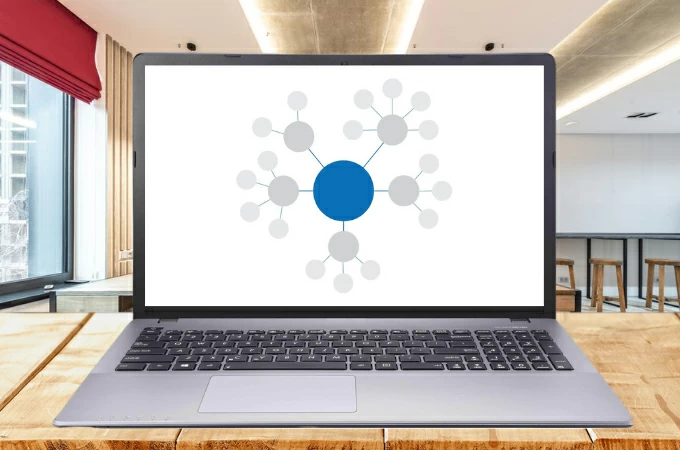
If you’re on a research team and want to organize and illustrate what you know about a topic, creating a research concept map is a smart way to go. It’s a technique for brainstorming research topics or narrowing down a broad notion into a more focused one. Concept maps can also be used to assist you to establish keywords for database searching or to help you come up with a thesis statement for your assignment. Keep reading to learn more about this great technique as well as the procedures for making one.
How to Make Research Concept Map?
What is a concept map, stages in making a research mind map, how to create research concept map online, importance of utilizing a concept map.
A mind map about research is a visual representation of your understanding of a subject. Concept maps help in the organization of your thoughts and the exploration of relationships within a topic. To organize and illustrate what you know about a topic, make an idea map. They essentially represent the knowledge that we people hold in our minds regarding a certain subject.
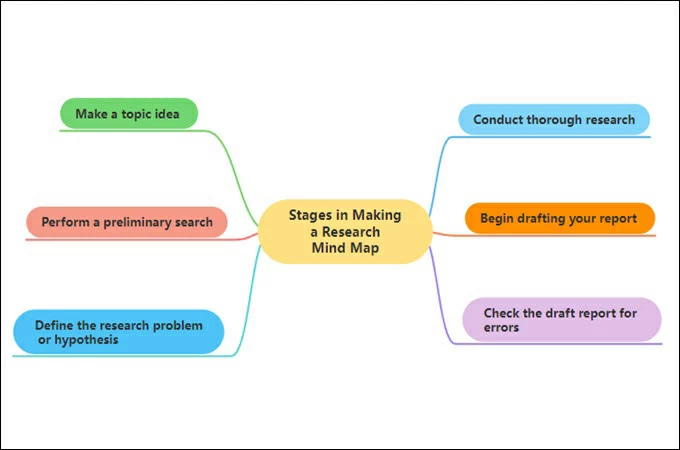
Make a topic idea – Determine your research mind map topic area by considering what you may possibly research in this area.
Perform a preliminary search – You must now determine whether you have sufficient resources to complete your investigation. Are those resources readily available? Is your topic too broad or too narrow?
Define the research problem or hypothesis – You should be able to establish the boundaries of your research now that you’ve done some preliminary investigation. Consider phrasing your research question as just a question to aid you in writing.
Conduct thorough research – According to a concept map regarding research, Conducting thorough research is one of the recognized resources for the problem or topic.
Begin drafting your report – Start your initial draft with the principal purpose of your report if you’ve described it. If not, submit a one-sentence summary that answers the following question: What is your report’s story?.
Check the draft report for errors -Finally, the report is updated and double-checked at this stage, and research mind map example diagrams and other visual aids are added.
Create professional-looking mind maps with GitMind . This tool is an online brainstorming and graphic design tool that allows users to easily build visualizations such as research concept map models, flowcharts, and other graphic representations. Additionally, this program provides free editing options while also allowing users to send their outputs by URL and edit them wherever they are. Having stated that, the detailed processes for creating a research concept map utilizing this program are provided below.
- First, go to GitMind’s official website and click the “Get Started” button to start.
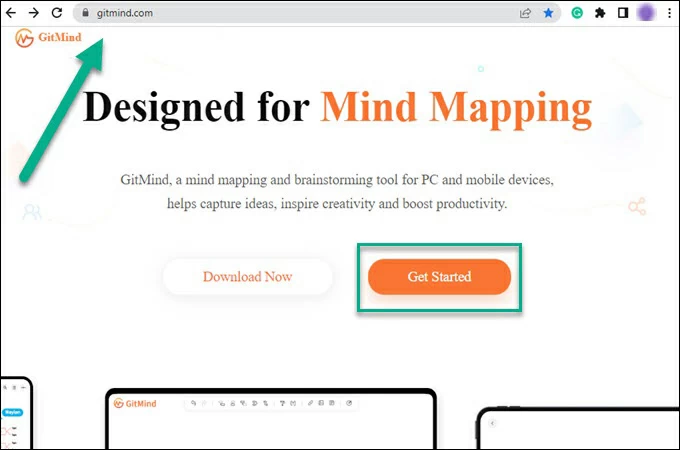
- Choose the “Mindmap” tab and hit the “New Mindmap” button to start making a mindmap.
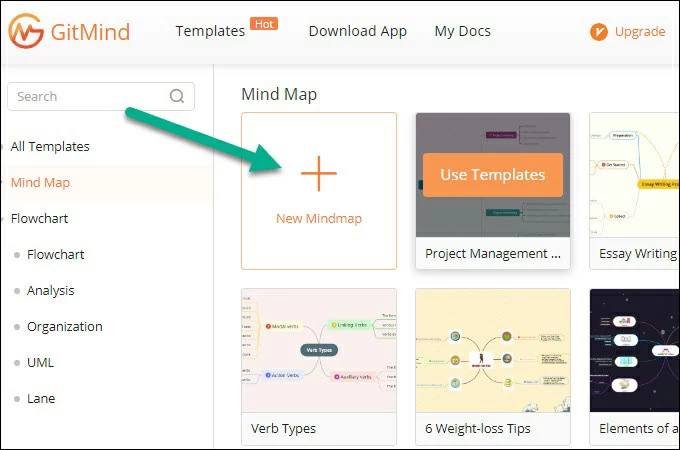
- From there, you can start customizing your concept map for research.
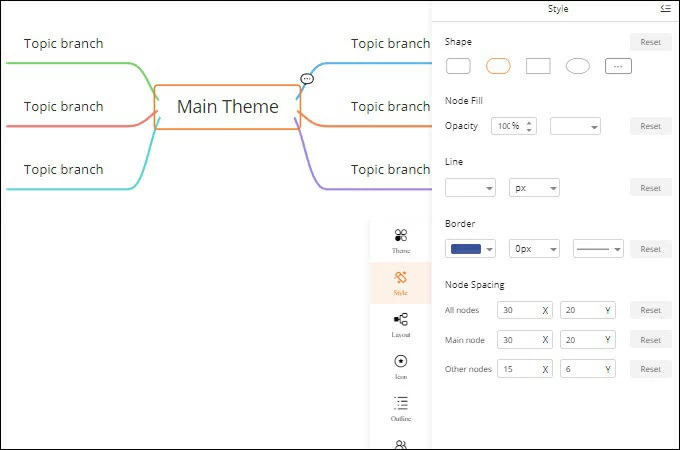
- Once done, click the “Save” button to save the modification, also if you can share your outputs via the URL link by simply hitting the “Share” button.
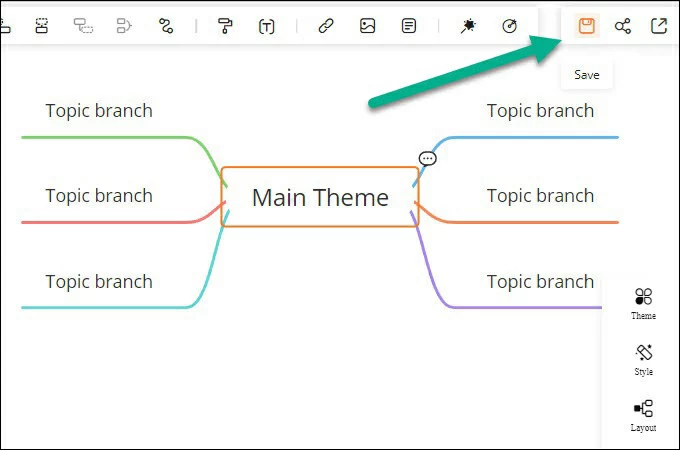
Both speakers and people learning new material might benefit from concept mapping. People can frequently absorb ideas far more rapidly with a research mind map than they can by reading them inside an article or book. This visual way of presenting information that makes it quickly understandable. Because of its simplicity and highlighting of crucial aspects, people can easily read thru a conceptual framework for quick comprehension of the complete system. This can be incredibly useful in a variety of situations, such as a work event when attendees must quickly examine the benefits of new initiatives.
All in all, concept mapping can truly help the organization of a presentation in a logical manner. Visualizations are logical by nature and emphasize clarity as well as order. Presenters are guided to create brief, logical presentations by forcing this structure on them. Even if the user isn’t presenting the research concept map during the presentation, a presenter may build a concept map as a way of arranging his presentation notes. Furthermore, software such as GitMind makes constructing a concept map much easier.
Related posts:
- Best 8 Free Online UML diagram tools in 2024
- What is A Probability Tree Diagram and Real Life Uses
Leave a Comment
Comment (0).
This website uses cookies that are essential for the operations of this website and its core functions. Other cookies will only be placed with your consent. For more details visit our Cookies Policy .

Concept Mapping for Research Projects

Introduction
What is concept mapping in research, what is the purpose of concept mapping, examples of concept maps, how are concept maps used in research, benefits of a concept map, what is the concept mapping process.
Concept mapping is a straightforward yet powerful technique that offers a bird's eye view of scientific knowledge and connections between ideas. Through concept mapping, research can be systematically arranged to allow researchers to analyze complex topics, making it easier to see how different concepts relate to one another.
It transforms abstract thoughts into a clear, visual representation of scientific knowledge, acting as a practical tool for bridging brainstorming and detailed data analysis . Concept mapping is especially beneficial for uncovering relationships between concepts that may not be immediately obvious.
This article outlines what the concept mapping process entails, its purposes, and its advantages. It also provides a step-by-step guide on creating concept maps for your research project, supplemented with examples.

Concept mapping for qualitative studies is a valuable tool that allows researchers to visualize the relationships between different ideas, concepts, or pieces of information. It involves creating a diagram that showcases how various elements are interconnected, often revealing patterns, hierarchies, and associations that might not be evident through text alone. The map starts with a central idea or question and branches out to show how subsidiary ideas connect to it and to each other.
This technique is grounded in the cognitive sciences, reflecting how the brain organizes and structures knowledge. By mapping out concepts, researchers can more easily comprehend the scope of a project, identify gaps in knowledge, and determine the direction of their inquiry. It serves not just as a method for organizing thoughts but also as a tool for critical thinking and analysis.
In the context of research, concept mapping can be used at various stages of a project. Initially, it can help in formulating a research question or questions by visually exploring the key themes and variables involved. Throughout the research process, concept maps can be adapted and expanded to incorporate new findings and insights, making them dynamic tools for understanding and communication.
Moreover, concept mapping fosters collaboration among research team members, providing a shared visual language that can bridge disciplinary divides. It can visually present complex ideas, making discussions more productive and helping to align the team’s understanding and approach.
A concept map shows scientific knowledge in an organized manner. Moreover, it serves as a multifaceted tool designed to enhance comprehension, communication, and collaboration in research. At its core, concept mapping aims to clarify complex ideas and relationships, making abstract concepts more accessible and understandable. This clarity is achieved by visually representing ideas, which helps researchers and stakeholders alike grasp the breadth and depth of a project more intuitively.
One primary objective of concept mapping is to foster critical thinking and analytical skills regarding a particular research topic . By visually laying out the connections between concepts, researchers are encouraged to explore and question the nature of these relationships, potentially uncovering new insights or identifying underlying assumptions. This process promotes a more thorough examination of the subject matter, encouraging a deeper engagement with the material.
Furthermore, using concept maps can aid in the identification of gaps in knowledge. By organizing concepts visually, it becomes easier to spot areas that are underexplored or lacking in evidence. This can guide future research directions, ensuring that efforts are focused on filling these gaps and advancing understanding of the topic.
Another significant purpose of concept mapping is to enhance collaboration among researchers. By providing a clear and shared visual representation of a project’s structure, concept maps facilitate communication among team members, regardless of their disciplinary backgrounds. This shared understanding helps to align research efforts, streamline decision-making processes, and encourage collaborative problem-solving.
Concept maps are versatile tools that can be applied across diverse research areas to clarify complex ideas and foster deeper understanding. Below are conceptual examples from different domains, showcasing how concept maps can be tailored to specific research needs.
Environmental science
Imagine a study that employs mind mapping to focus on the impacts of climate change on coastal ecosystems. Researchers could use concept mapping to illustrate the intricate relationships between species, habitats, and environmental stressors. The map might center on "Coastal Ecosystems," branching out to related concepts like "Sea Level Rise," "Salinity Changes," and "Species Migration." This visual representation could help in understanding the multifaceted effects of climate change, guiding conservation efforts and policy development.
In exploring factors that influence student motivation, educational researchers might create a concept map to visualize connections between the classroom environment, teaching methods, and student engagement. Key elements such as "Active Learning," "Feedback," and "Classroom Climate" could be linked to impact "Student Motivation." This concept map could serve as a foundation for strategies to boost engagement and learning outcomes, demonstrating concept mapping's applicability in educational interventions.
Health sciences
For a study on Alzheimer's disease progression, a concept map could delineate complex pathways leading to neuronal degeneration. Featuring "Alzheimer's Disease" at its center, branches could extend to "Genetic Factors," "Environmental Influences," and "Biochemical Processes." This approach might identify potential therapeutic targets and help address health challenges.
Technology and business
Researching how small businesses adopt new technologies could involve a concept map exploring decision-making factors. The central theme "Technology Adoption" might connect to "Cost-Benefit Analysis," "Organizational Culture," "Market Trends," and "Regulatory Environment." This method could capture the multifaceted nature of technology adoption decisions, aiding in the development of supportive strategies for small businesses.

Visualize your research with ATLAS.ti
Powerful, intuitive tools bring your research project to life. Try out a free trial of ATLAS.ti today.
Concept maps are utilized in research to facilitate a range of critical activities, from the initial stages of project planning to the dissemination of research findings. Their use enhances the clarity, organization, and effectiveness of research efforts in several key ways.
At the outset of a research project, a concept map can help in defining the scope and objectives. Researchers can use a concept map to identify and visually represent the main themes and questions their project will address. This early visualization aids in pinpointing the focus areas and can highlight potential research questions or hypotheses that warrant further exploration.
Throughout the research process, concept maps serve as dynamic tools for organizing and synthesizing information. As new data is collected and analyzed, the concept map can be updated to reflect new insights, connections between concepts, and emerging patterns. This ongoing adjustment helps researchers maintain a clear overview of their project, ensuring that their data analysis remains structured and focused.
Concept maps also play a crucial role in identifying relationships between variables and in revealing gaps in existing knowledge. By laying out the known connections and highlighting areas with limited information, researchers can more easily identify where further investigation is needed, guiding the direction of subsequent research efforts.
In terms of collaboration and communication, concept maps are invaluable. They provide a visual language that can be shared among team members and stakeholders, facilitating discussions and ensuring that all parties have a common understanding of the project’s framework and findings.
Finally, when presenting research outcomes, concept maps can effectively summarize and convey complex information to diverse audiences. They can be used in reports, presentations, and publications to illustrate the study’s structure, findings, and implications clearly and concisely, making the research accessible to both academic and non-academic audiences.
Concept maps offer a range of benefits that enhance the research process, making complex information more manageable and comprehensible. These benefits can be broadly categorized into improving understanding, facilitating communication, and aiding in the planning and organization of research.
Enhancing understanding
Concept maps help distill complex ideas into visual formats, making abstract concepts more tangible. By laying out the relationships between different pieces of information, these maps enable researchers to see patterns and connections that might not be obvious in textual form. A concept map can lead to a deeper understanding of the subject matter, as it encourages the identification of relationships, hierarchies, and networks within the research topic .
Facilitating communication
One of the key advantages of concept maps is their ability to act as a communication tool among research team members and with external stakeholders. They provide a shared visual language that can help in explaining ideas clearly and succinctly, bridging knowledge gaps between individuals with different expertise or backgrounds. This common ground is especially valuable in multidisciplinary research teams, where understanding each others' perspectives is crucial for collaborative success. Moreover, concept maps can be effective in presentations or publications by conveying findings and theories in a more engaging and understandable way.
Aiding planning and organization
In the context of research planning and organization, concept maps serve as an invaluable tool for structuring projects and outlining research strategies. They allow researchers to visually map out the scope of their study, identify key components and variables, and organize their approach to data collection and analysis. This can support a more efficient use of resources and time, as potential overlaps or gaps in research can be identified early in the process. Furthermore, concept maps can be used to track progress over time, providing a clear overview of how individual pieces of research contribute to the overall project goals.
The process of creating a concept map involves several structured steps that guide researchers from the initial exploration of a topic to the development of a comprehensive visual display of their ideas and findings. This process can be divided into key phases: starting with a literature review , drafting an initial mind map, and refining the concept map into a final version.
Conducting a literature review
The first step to creating a concept map is to conduct a thorough literature review. This stage is crucial for gathering existing knowledge on the topic, identifying key concepts, theories, and relationships that have been previously established. The literature review helps in framing the main idea or question that will be at the center of the concept map. It provides a solid foundation of information from which researchers can begin to build their map, ensuring that it is grounded in established research and theory.
Drafting an initial map
With a clear understanding of the topic from the literature review, the next step is to start drafting an initial concept map. This can begin as a simple mind map, with the main idea at the center and primary concepts branching out from it. Researchers can then add layers of detail, linking related concepts and indicating the nature of their relationships. This initial draft is a flexible tool, allowing for easy adjustments as new ideas emerge or as the structure of the map evolves.
Refining the concept map
The last phase involves refining the initial draft into a final version of the concept map. This step may require multiple revisions, as researchers review their concept map for clarity, coherence, and completeness. It's an opportunity to ensure that all relevant concepts are included and accurately represented. The final version should clearly convey the main idea, its supporting concepts, and their interconnections. This polished concept map can then be used for various purposes, such as the basis for a research project, a visual aid in a blog post, or a tool for communication within a research team.

Turn ideas into insights with ATLAS.ti
ATLAS.ti assists you with the entire research process, from initial mind maps to findings. See how with a free trial.

- Search Site
- Campus Directory
- Online Forms
- Odum Library
- Visitor Information
- About Valdosta
- VSU Administration
- Virtual Tour & Maps Take a sneak peek and plan your trip to our beautiful campus! Our virtual tour is mobile-friendly and offers GPS directions to all campus locations. See you soon!
- Undergraduate Admissions
- Graduate Admissions
- Meet Your Counselor
- Visit Our Campus
- Financial Aid & Scholarships
- Cost Calculator
- Search Degrees
- Online Programs
- How to Become a Blazer Blazers are one of a kind. They find hands-on opportunities to succeed in research, leadership, and excellence as early as freshman year. Think you have what it takes? Click here to get started.
- Academics Overview
- Academic Affairs
- Online Learning
- Colleges & Departments
- Research Opportunities
- Study Abroad
- Majors & Degrees A-Z You have what it takes to change the world, and your degree from VSU will get you there. Click here to compare more than 100 degrees, minors, endorsements & certificates.
- Student Affairs
- Campus Calendar
- Student Access Office
- Safety Resources
- University Housing
- Campus Recreation
- Health and Wellness
- Student Life Make the most of your V-State Experience by swimming with manatees, joining Greek life, catching a movie on the lawn, and more! Click here to meet all of our 200+ student organizations and activities.
- Booster Information
- V-State Club
- NCAA Compliance
- Statistics and Records
- Athletics Staff
- Blazer Athletics Winners of 7 national championships, VSU student athletes excel on the field and in the classroom. Discover the latest and breaking news for #BlazerNation, as well as schedules, rosters, and ticket purchases.
- Alumni Homepage
- Get Involved
- Update your information
- Alumni Events
- How to Give
- VSU Alumni Association
- Alumni Advantages
- Capital Campaign
- Make Your Gift Today At Valdosta State University, every gift counts. Your support enables scholarships, athletic excellence, facility upgrades, faculty improvements, and more. Plan your gift today!
Developing a Research Topic: Concept Mapping
- Concept Mapping
- Developing Keywords for Searching
- Boolean, Truncation, and Wildcards
- Topic Ideas
- Writing a Research Question

Concept Map / Mind Mapping
What is a concept map.
A concept map is a visual representation of what you know about a topic. Concept maps help you organize your thoughts and explore the relationships in a topic. Use a concept map to organize and represent what you know about a topic. Explore the connections between elements of the topic.
Why use a concept map?
Concept maps can be used to develop a research topic. They are a useful brainstorming tool.
Concept maps can be used to study. Mapping what you know about a subject and examining the relationships between elements help you develop a greater understanding of the material.
How do I create a concept map?
- On a whiteboard
- Any way that works for you!
How do I organize the map?
Most of the time you start with the central idea, topic, or subject. Then you branch out from that central point and show how the main idea can be broken into specific subtopics. Each subtopic can also be broken into even more specific topics,
Make a Research Appointment
Click Make a Research Appointment to schedule a meeting with a librarian!
Organize what you know by subtopic in a topic map.

Use the topic map to define your research topic.
For example: geography - local travel - rail - variants - rail systems - designs & availability - emissions - research & evidence

Make a topic statement or research question.
I am researching the environmental impact of using commuter rail systems in cities.
How does using commuter rail systems in cities affect the environment?

Concept Map, Mind Mapping
Example concept map.

- Next: Developing Keywords for Searching >>
- Last Updated: Sep 18, 2023 11:56 AM
- URL: https://libguides.valdosta.edu/research-topic
- Virtual Tour and Maps
- Safety Information
- Ethics Hotline
- Accessibility
- Privacy Statement
- Site Feedback
- Clery Reporting
- Request Info

- Research Guides
Literature Review: A Self-Guided Tutorial
Using concept maps.
- Literature Reviews: A Recap
- Peer Review
- Reading the Literature
- Developing Research Questions
- Considering Strong Opinions
- 2. Review discipline styles
- Super Searching
- Finding the Full Text
- Citation Searching This link opens in a new window
- When to stop searching
- Citation Management
- Annotating Articles Tip
- 5. Critically analyze and evaluate
- How to Review the Literature
- Using a Synthesis Matrix
- 7. Write literature review
Concept maps or mind maps visually represent relationships of different concepts. In research, they can help you make connections between ideas. You can use them as you are formulating your research question, as you are reading a complex text, and when you are creating a literature review. See the video and examples below.
How to Create a Concept Map
Credit: Penn State Libraries ( CC-BY ) Run Time: 3:13
- Bubbl.us Free version allows 3 mind maps, image export, and sharing.
- MindMeister Free version allows 3 mind maps, sharing, collaborating, and importing. No image-based exporting.
Mind Map of a Text Example

Credit: Austin Kleon. A map I drew of John Berger’s Ways of Seeing in 2008. Tumblr post. April 14, 2016. http://tumblr.austinkleon.com/post/142802684061#notes
Literature Review Mind Map Example
This example shows the different aspects of the author's literature review with citations to scholars who have written about those aspects.

Credit: Clancy Ratliff, Dissertation: Literature Review. Culturecat: Rhetoric and Feminism [blog]. 2 October 2005. http://culturecat.net/node/955 .
- << Previous: Reading the Literature
- Next: 1. Identify the question >>
- Last Updated: Feb 22, 2024 10:53 AM
- URL: https://libguides.williams.edu/literature-review
- Video Tutorial
- Support Forum
- Submitted Maps
Oops! The page you were looking for doesn’t exist.
Back to previous page or the homepage
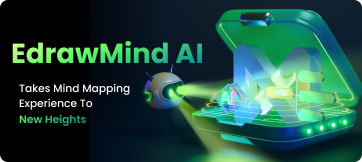
- Mind Map Maker
- Concept Map Maker
- Bubble Map Maker
- Brace Map Maker
- Sunburst Chart Maker
- Online AI Note Taker
- Timeline Maker
- Tree Diagram Maker
- Fishbone Diagram Maker
- Organizational Chart Maker
- Gantt Chart Maker
- Spider Diagram Maker
- EdrawMind AI
- AI Summarize
- AI Mind map
- AI Article generation
- AI Copywriting
- AI Translation
- --> --> >--> -->